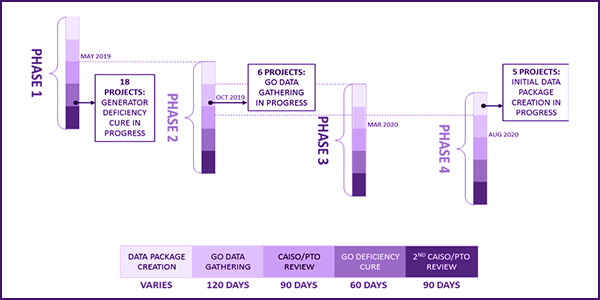The lack of reliable modeling and simulation resources for inverter-based resources (IBRs) continues to pose a serious challenge for reliable operation of the North American electric grid, members of NERC’s Inverter-based Resource Performance Task Force (IRPTF) warned in a webinar on Monday.
Presenting a recent report on a questionnaire following up on two NERC Alerts issued after the 2016 Blue Cut and 2017 Canyon 2 fires, Ryan Quint — NERC’s lead engineer for advanced system analytics and modeling — said that many generator owners (GOs) and transmission planners had yet to fully act on NERC recommendations regarding modeling of solar photovoltaic resources to prevent momentary cessation (MC). Both incidents resulted in considerable shortfalls in solar PV generation: 1,200 MW of generation for Blue Cut and 900 MW for Canyon 2.
In particular, the alert following the Canyon 2 fire recommended that GOs ensure that the dynamic models being used accurately represent the dynamic performance of the solar facilities and work with inverter manufacturers to identify changes that could help eliminate or reduce MC as much as possible. In the follow-up questionnaire, transmission planners and planning coordinators complained that GOs had failed to follow through on this advice.
“Many of the TPs and PCs stated that no models were provided or that minimal modeling improvements were provided,” said Quint. “But really the biggest issue was that the models that were provided … were incorrectly parameterized [or] not considered usable … They weren’t matching the list of acceptable models defined by the TP or the PC, or in some cases they were just the wrong model entirely.”
System planners were not blameless either, as most reported making little effort to follow up on missing or incorrect modeling information. While the report did not attribute a specific cause to this lack of action, one likely reason was the failure of the NERC alert to provide a mechanism for doing so, which left PCs and TPs unsure about their responsibilities, IRPTF staff said. Indeed, those planners that followed up with GOs did so largely “outside the NERC Alert process,” according to the report.
CAISO Modeling Updates Challenged
To illustrate the challenges in obtaining accurate modeling information, IRPTF highlighted the model update process implemented by CAISO in 2018. The ISO created the process in response to the Canyon 2 NERC Alert, with all generator owners participating in the CAISO market required to follow a five-step process:
- CAISO and participating transmission owners create a package for each GO to gather updated modeling data.
- GOs collect the necessary modeling information and provide it to CAISO within 120 days of receiving the request.
- CAISO and its TOs review the data to ensure acceptable performance, sending feedback to the GO within 90 days.
- GOs have 60 days to address any deficiencies identified.
- GOs resubmit modeling data for a second 90-day review by CAISO and TOs.
As of Sept. 25, 2019, CAISO had received updated models accounting for 109 resources with nearly 14 GW of capacity. Of the models provided, 101 had been reviewed at the time of the report’s publication, with 95 identified as deficient. Of those, just 10 have been resubmitted with proposed corrections.
A lack of accurate models could have serious consequences for the ability of system planners to understand the behavior of connected generators under stress, but the IRPTF says their ability and inclination to push generator owners for better information may be limited by the current state of NERC reliability standards. Staff said these may need to be updated to provide the impetus needed by industry operators on both sides.
“With a synchronous machine, it’s a little more straightforward on how these models work … It’s really physics,” Quint said. “These new inverter-based resource models are much more complicated and there’s a lot of nuance. It’s hard to parameterize these models and it really requires expert input, so there’s a huge accountability issue here on who’s going to take responsibility for making sure these models get updated.”




